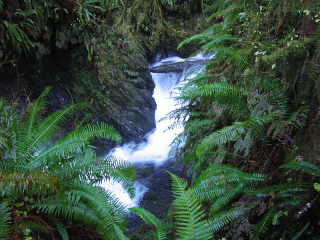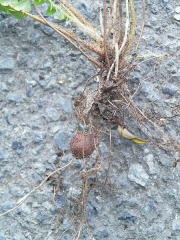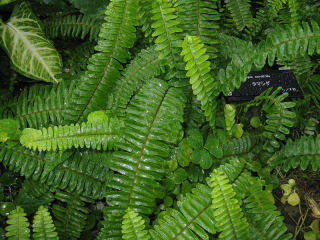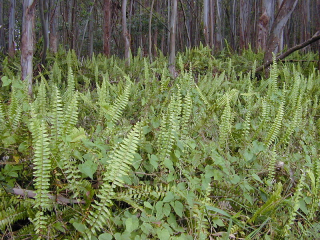The common sword fern (Nephrolepis cordifolia), also called the tube ladder fern, ladder fern, erect sword fern, bayabang or fishbone fern, is common in Perth gardens. It is native to northern Australia and Asia, and it’s hardy enough that it is classified as an invasive species is some areas where it has been introduced. It survives, and even thrives in sandy Perth soils (basically beach sand) with no care or attention. What you probably didn’t know about the sword fern is that it produces edible tubers.
Sword fern can be either terrestial or epiphytic. The fronds are 20 to 60 cm long, 2.5 to 5 cm wide. Leaves are pinnate; the leaflets are entire to slightly toothed, with kidney-shaped, brown spore packets on the underside. The plant produces a horizontal root (rhizome), with wiry side roots (stolons) growing off it, both densely clothed with brownish scales. Growing on the stolons will be the tubers. The tubers are fleshy and round or egg-shaped, usually 0.5 – 2 cm in diameter, occurring on the Rhizomes of the fern. From the plant’s point of view the tubers are for water storage. They are present year round, and can be harvested without damaging the fern, provided it is replanted after harvest and provided with sufficient water.
A team in Nepal tested the tubers of Nephrolepis cordifolia for nutritional content [Nutrient Analysis of Nephrolepsis, Kathmandu University Journal of Science, Engineering and Technology, Vol 4, No 1 (2008)]. The study concluded that the tubers are a rich source of carbohydrates and calcium (96% water, 13.42% carbohydrates, 1.34% protein, 1.25% starch, 14.88% crude fiber, 6.53% ash, 0.75% calcium and trace phosphorus), and also noted that they are frequently eaten raw by children in the region. The team recommended the tubers be investigated as a potential commercial crop.
The tubers can range in color from cream to yellow to dark tan or brown, and can be eaten raw or cooked. Raw, they are described as being crunchy and sweet, or similar to Jerusalem artichokes, with a verying amount of astringency and a slight brackeny or earthy taste. Apparently if you roast large ones in a slow oven the turn into sweet, chewy lumps. Small ones keep their shape but turn to a powder inside that tastes like coffee.
What sword fern needs:
- Water – Sword fern thrives in many environments, ranging from semi-arid Mediterranean climates such as Perth through to the humid tropics (e.g. Florida, north-eartern Australia) and even temperate areas (New Zealand). It requires around 600mm of rainfall or irrigation per year, but can survive extended dry periods.
- Sunlight – sword fern, like most ferns, prefers a semi-shaded position, protected from the harsh light and heat of the midday sun. It can survive in positions where it gets full sun on the morning, but is shaded during the middle of the day, but prefers filtered light.
- Soil – Sword ferns can survive as epiphytes, and do not require rich soil. They need reasonable drainage, but will do well in damp areas. Tuber production may be lower if water is constantly available.
- Space – Sword ferns are not large plants. They can be grown in pots or small garden beds, and will spread to fill the available space.
- Warmth – Sword ferns are damaged by very low temperatures. They don’t like frost, although they can survive a light frost – and as they are classed as invasive in New Zealand, it seems safe to assume that they can survive quite cold weather.
What sword fern has to offer:
- Edible tubers.
- Attractive, hardy groundcover plant for landscaping.
- New ferns, from spores and rhizomes.
-
For more info, see the following sites:
- Eat The Weeds site
- Radix 4 Roots
Images sourced from Wikimedia Commons:
File:Quinault_Small_Waterfall.jpg
File:Nephrolepis_cordifolia_tamasd02.jpg
File:Tuberous_sword_fern.jpg
File:Nephrolepis_cordifolia_%28Sori%29.jpg
File:Nephrolepis_cordifolia1.jpg
File:Starr_030405-0138_Nephrolepis_sp..jpg




